Monthly economic brief: January 2022
The monthly economic brief provides a summary of latest key economic statistics, forecasts and analysis on the Scottish economy.
This document is part of a collection
Business Activity
The latest survey data indicate that the pace of growth slowed in December as Omicron started to impact activity.
Business Output
- The Purchasing Managers Index (PMI) business survey signalled further private sector business activity growth in December, however the growth indicator fell to its lowest level in 10 months (52.7) indicating a slowdown in the pace of growth in Scotland, with the wider survey signalling a slowdown across the UK as a whole.[2]
- Growth in inflows of new business/orders particularly slowed over the month, with concerns around Omicron and tightening of restrictions likely a key factor weighing on activity.
Purchasing Managers’ Index: Scottish Business Activity 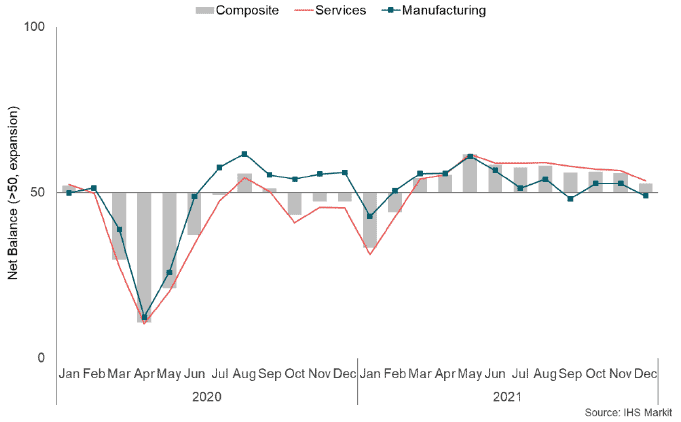
- Looking ahead, business optimism in Scotland eased slightly over the month (67.0), though remained strong overall, with anecdotal evidence in the survey suggesting that businesses are hopeful that pandemic and Brexit related issues will diminish over the coming year.
- In the short term however, the latest flash UK PMI data for January indicates that private sector growth, while remaining positive, may have softened slightly further at the start of 2022, particularly in consumer services most directly impacted by Omicron restrictions, while manufacturing activity picked-up slightly supported by an improvement in materials availability.[3]
Trading status
- During the second half of 2021, business survey data indicated that close to all businesses in Scotland were trading in some form following the move beyond level zero restrictions.[4] The emergence of the Omicron variant in November 2021 meant that increased restrictions limiting social interaction, requirements around testing and self-isolation, alongside closure of nightclubs, limits on capacity at indoor hospitality and leisure settings and attendance at large events, were introduced over the course of December.
- The latest business survey data into the start of January indicates that the share of businesses currently trading fell marginally to 98%, however this was mainly driven by a fall in the share of accommodation and food services businesses trading from 99% to 91%. There were further differences in the capacity at which firms reported they were trading with 88% of all businesses reporting as fully trading (10% partially trading). This reflected a slight fall in the proportion of businesses fully trading across almost all sectors, but most notably in accommodation and food services in which 60% of businesses reported as fully trading (down from 84%) and 31% partially trading.
Business Trading Status by Sector (29 Dec – 9 Jan) 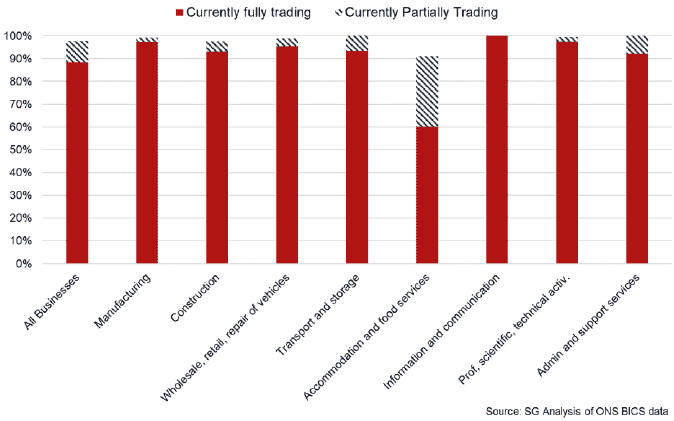
- Several factors will have impacted business activity and trading status at the start of the new year, including the holiday season, as well as the increased restrictions and their impact on demand, capacity and staffing availability.
Business turnover and input costs
- The financial context of businesses also continues to vary across sectors. In terms of business turnover in December and into the start of January, 29% of all business reported having lower turnover than normal for the time of year, while 48% reported that turnover was not affected and 12% reported that it had increased.[5]
- The share of businesses reporting decreased turnover increased moderately in December (29%, up from 25% in November), however remained broadly stable in the context of recent fluctuations in the time series.
- Lower than normal turnover continued to be most widespread in the accommodation and food services sector, with 57% of businesses in the sector reporting this in December and into the start of January. The share had also risen sharply from 49% in November and 40% during October, indicating that turnover has been impacted during the Omicron wave. However, the shares of businesses reporting lower than normal turnover, remained notably lower than earlier in the pandemic.
- Notable shares of most other sectors continued to report that turnover had not been affected, while accommodation and food services also had amongst the highest share of firms reporting that turnover had increased (15%) alongside the transport and storage sector (18%) and wholesale, retail and repair of vehicles (18%), emphasising the level of variability of demand within sectors.
How turnover in the previous two weeks compares to what businesses would normally expect for this time of year (survey: 29 Dec – 9 Jan) 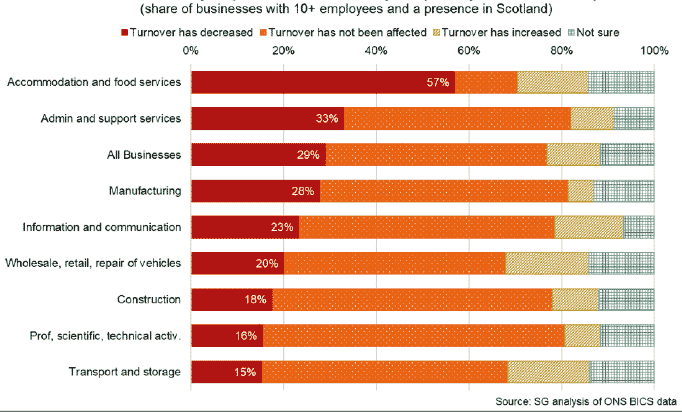
- On the cost side, supply chain disruption, high input cost inflation and employee shortages have emerged as key challenges and risks for many businesses at this stage of the recovery.
- Input cost pressures (e.g. raw materials and energy) remained elevated in November with latest BICS data indicating that 45% of businesses had seen prices increase more than normal, and most prominently in manufacturing (64%) and construction (64%).[6]
The share of businesses that have reported the prices of materials, goods or services bought has increased, compared with normal price fluctuations 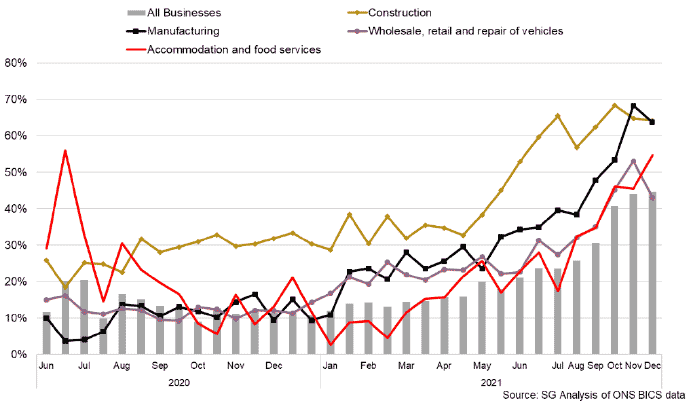
- Scottish PMI data also showed the indicator for input cost inflation remained elevated in December, indicating that prices continued to rise (75.9), albeit at a slightly slower rate than in November. A range of factors including fuel, transport and materials costs continued to be cited by the survey respondents as sources of inflationary pressures. PMI data also indicated that firms continued to partly pass on greater costs through to customers, though similarly at a slower rate than in November.[7]
Trade
- Latest trade data provides Scotland’s international goods trade up to Q3 2021[8] while BICS data provides latest insights on trade challenges for businesses in the final quarter of 2021 and start of 2022.
- Compared to the year ending in Q3 2019, the value of Scotland’s annual goods exports for the year ending in Q3 2021 had decreased by 24.8% to £25.9 billion. The biggest driver of the decrease over this period was exports of oil and gas, which decreased by more than half. When excluding oil and gas, the decrease in Scotland’s goods exported over the period fell to 5.6%. The value of Scotland’s annual goods imports for the year ending in Q3 2021 also decreased over this period by 13.2% to £21.8 billion.
Scotland’s Annual International Goods Exports and Imports 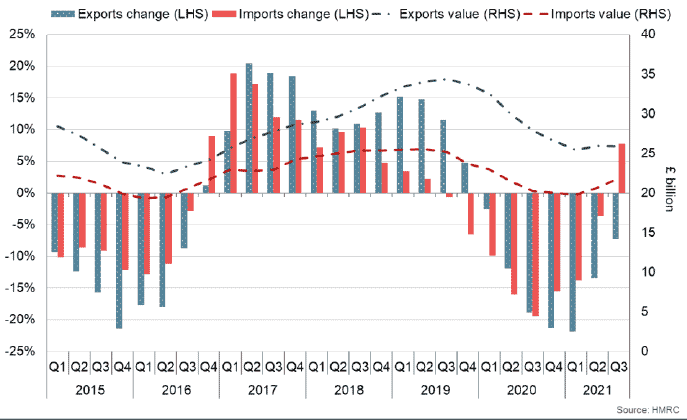
- BICS data for the end of December and into the beginning of January indicates some stabilisation in trade indicators in recent months, while they remain improved from earlier in 2021, with 62% of Scottish businesses reporting to be exporting as normal for the time of year (up from 42% at the start of February 2021) while 23% were exporting less than normal (down from 38% at the start of February 2021).[9]
How business exporting/importing in the previous 2-weeks compares with normal expectations for the time of year 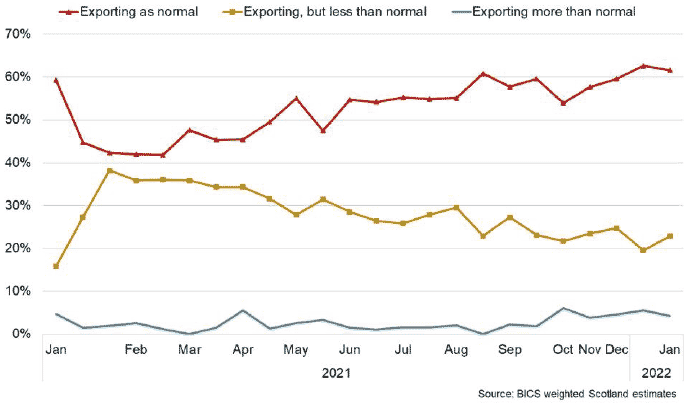
- However, supply chain bottlenecks continue to present significant challenges in December and at the beginning of January with 50% of exporters and 53% of importers reporting facing changes in transportation costs while 17% of exporters and 21% of importers reported a lack of hauliers to transport goods or lack of logistics equipment.[10]
Contact
Email: OCEABusiness@gov.scot
There is a problem
Thanks for your feedback